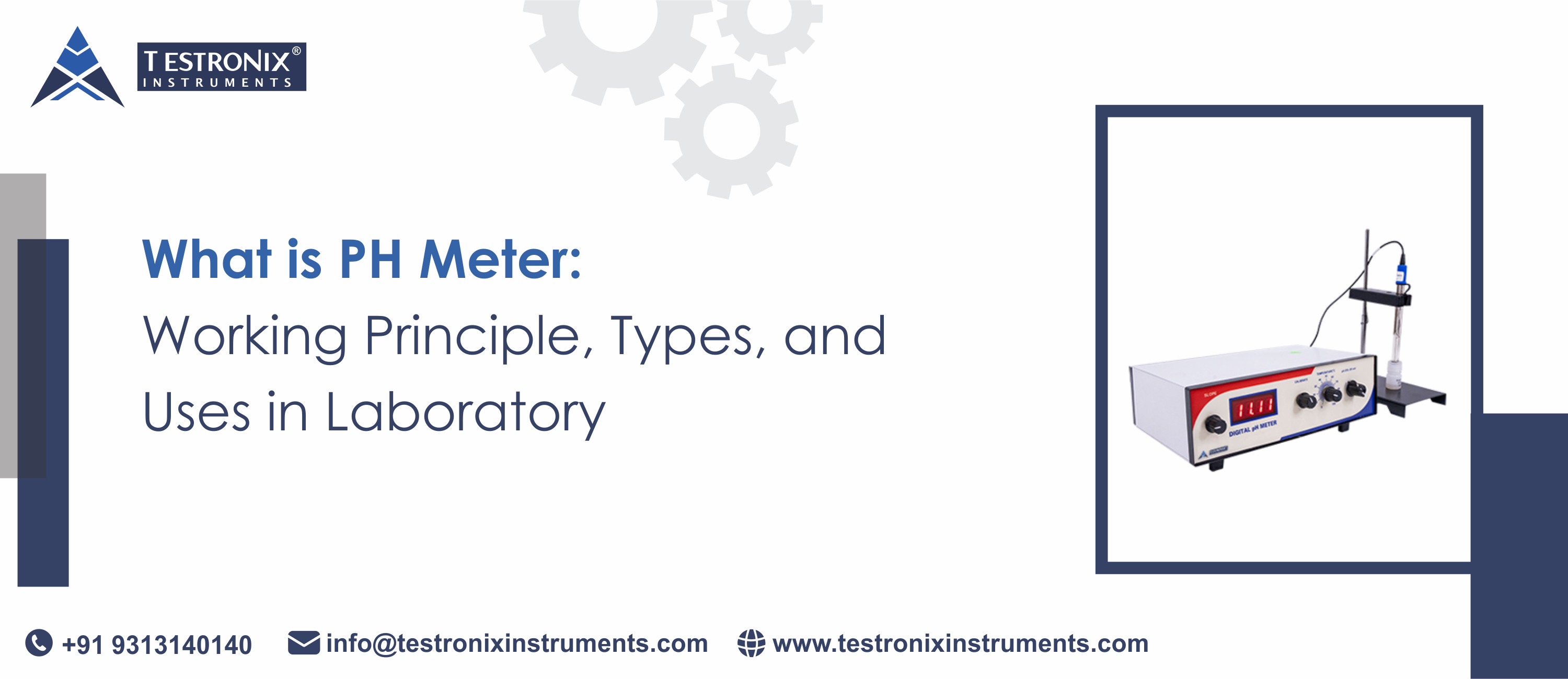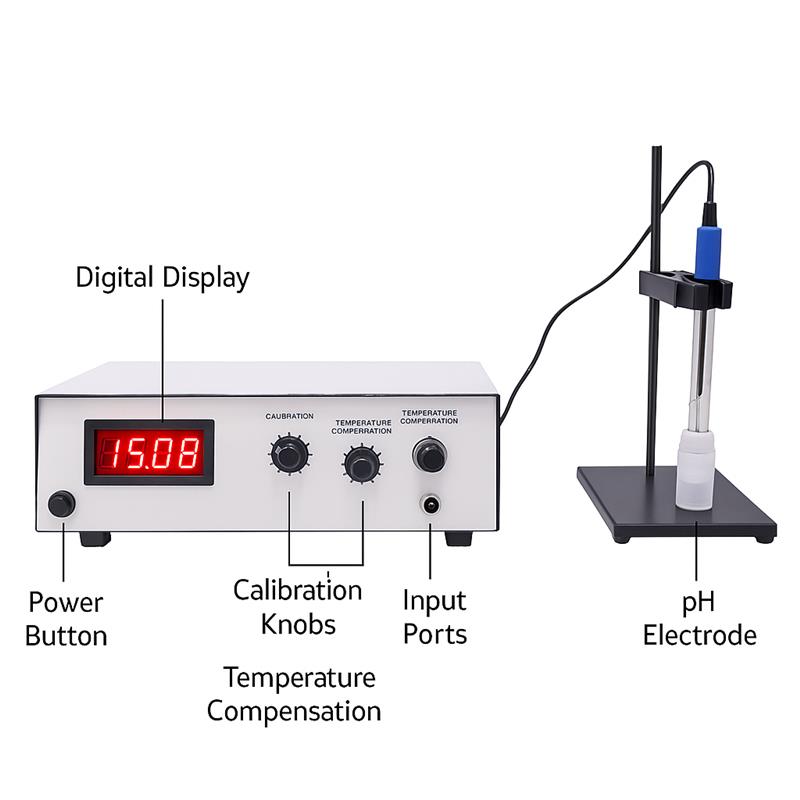Reviewed by Anurag Mishra (Sr. Technical Consultant)

A pH meter is an essential device for laboratories to determine the acidity and alkalinity measurements of solutions. All fields, including chemistry, biology, environmental science, food, and pharma, need pH meters due to their precise operation. It gives an accurate pH measurement while assisting in water treatment, farming, food processing, and labs.
Through measuring pH levels, it facilitates quality control, safety, and the best conditions for different chemical and biological reactions. We will discuss the fundamental features of a pH meter in this article, along with its principle and different varieties and laboratory applications.
A pH meter is a scientific device to detects the measurement of acidity levels or alkalinity within a solution. The hydrogen ion concentration of a solution can be measured by this device. It measures solutions with the help of a pH scale that extends from 0 to 14.
This device finds its main applications in chemical equilibrium maintenance and product quality control, as well as safety operations in labs and water treatment facilities, along with food production facilities, pharmaceuticals, and industrial applications.
What is a Water Bath in a Laboratory?
What is Environmental Stress Crack Resistance (ESCR)?
pH meter full form is “potential of hydrogen” or “power of hydrogen”. The device measures the activity present in solutions through H? hydrogen ions. The solution develops acid properties (lower pH value) because its H? concentration increases. A decreased H? level leads to a solution becoming brighter in alkalinity because pH values rise.

pH meter diagram consist of the major elements such as an electrode (probe sensor), reference electrode, and digital indicator. The electrode senses the hydrogen ion concentration within a solution that is translated to a pH figure appearing on the display. In some cases, a temperature probe, calibration devices, and source of power can also be featured in the diagram to make the reader familiarize himself with the pH meter operations.
A pH meter works by determining a solution’s hydrogen ion concentration through its measurement process. The pH meter shows its final reading by using electrical signals obtained from the glass electrode, which measures ion levels. A solution generates its pH status based on the readings from a pH meter, which identify acidic below 7, neutral at 7, and alkaline above 7. Regular calibration ensures accuracy.
The working principle of a pH meter is based on the generation of an electrical potential difference between reference and measuring electrodes. A pH meter operates by measuring the voltage difference that develops between its reference electrode and its measuring electrode.
The electrodes detect the hydrogen ions in solutions producing an electric charge. The meter uses the voltage to generate pH measurements. The system determines voltage levels through the application of the Nernst equation that relates to hydrogen ion densities:
Where:
A pH scale is a logarithmic scale to determine a solution’s acidic or alkaline levels. The measurement of the pH scale starts at 0 and extends to 14, while 7 represents the neutral value.
In the pH meter, multiple components function as a unit to evaluate solution pH levels regardless of their acidic or basic nature. A pH meter depends on every one of its components to achieve precise measurement results. All essential components included in a pH meter function as follows:
A specific glass membrane incorporated into the measuring electrode enables it to interact with the solution’s hydrogen ions. A small voltage develops during this reaction process while the measured pH level in the liquid varies accordingly. Within the electrode exists a solution with an established pH value for measuring the pH content of the test specimen.
A reference electrode functions to deliver constant voltage levels for examination purposes. A potassium chloride solution is present in the reference electrode, which uses a silver-silver chloride (Ag/AgCl) or calomel system. Its constant potential allows the pH meter to detect only the pH-related voltage changes in the solution.
Temperature causes variations in pH measurements, which is why contemporary pH meters include an integrated temperature measuring system. Temperature adjustment functions automatically in the device to deliver enhanced accuracy in the measurements.
Users can view the pH reading through the display unit that uses digital LCD or LED screens for presentation. Digital display screens outperform analog indicators while showing temperature and calibration status together with accurate results.
A pH meter needs periodic calibration to function properly until its accuracy level remains sustained. Users can perform pH meter calibration through calibration knobs or digital controls by using buffer solutions that have established pH values such as 4.0, 7.0, and 10.0. Automatic calibration features in recent pH meters reduce the difficulty and enhance their measurement precision.
There are multiple types of pH meters available based on portability and applications. Here are the types of pH meters in detail:
| Type of pH Meter | Description | Applications |
| Analog pH Meter | Older model with a needle display, requiring careful handling for accurate readings. | Used in labs for basic pH measurements. |
| Digital pH Meter | Improved version with a digital display, offering higher accuracy and reliability. | Common in labs and industries for precise pH measurement. |
| Pen-type pH Meter | Compact, portable device for quick pH measurements on the go. | Used in food production and field tests. |
| Handheld pH Meter | Larger than pen meters with replaceable electrodes, designed for field use. | Popular for water treatment, agriculture, and environmental monitoring. |
| Benchtop pH Meter | Large, accurate meters for laboratory use, offering high precision. | Common in labs, food processing, and environmental monitoring. |
The pH meter requires calibration before use that follows standard buffers set at the values of 4, 7, and 10. Place the electrode in distilled water before and after calibration to prevent contamination processes. Allow for stabilization of reading time before performing any necessary adjustments when placing the electrode in the pH 7 buffer. Execute the precise method again using pH 4 buffer and pH 10 buffer.
Drying the electrode with distilled water should be your first step before moving on to use it with new samples. Position the electrode within the sample solution, keeping it away from touching the container walls. Take down the pH measurement the moment the meter’s reading displays stability.
Clean the electrode with distilled water first, then use an electrode-cleaning solution if required before storing it. Using the right storage solution enables successful maintenance of electrolytic precision and lengthens the instrument's lifetime.
Multiple businesses throughout different industries make extensive use of pH meters. The devices deliver exact pH value measurements that scientists need for research activities and quality control functions as well as regulatory requirements. The applications of pH meters in laboratory use include:
A pH meter serves as a tool for scientists who check the chemical properties of acidic and alkaline solutions. The correct control of pH throughout chemical procedures contributes directly to procedure accuracy along with operational safety.
Medical & Pharmaceutical Industry
Medical fields and pharmaceutical production depend on pH meters for their clinical testing and drug formulation activities. Medical drugs require a precise pH level to achieve stability along with their effective functioning.
Food Industry:
The food industry uses pH meters as instruments to protect and verify the quality of dairy products and processed foods together with drinks.
Environmental Science
The field of environmental science relies on pH meters to determine the pollution levels across industrial waste sites and rivers and lakes and to evaluate water quality.
To evaluate soil pH levels, agriculture users must rely on pH meters that determine the acidity properties of soils, which affect both plant growth and how nutrients become available in the soil.
pH meters are vital equipment in laboratories and industries for accurate and efficient pH measurements. There are many benefits to a pH meter. But these meters have their set of limitations too.
The benefits of pH meters largely depend on the industry and use cases. The following are the benefits of pH meters -
Accurate and Fast Measurements
Compared to test strips or indicators, pH meters are more dependable because they provide accurate and immediate readings.
Easy to Use and Portable
Compact handheld versions are available for fieldwork, and many models have digital displays and are easy to use.
Widely Used in Laboratories and Industries
pH meters are vital instruments for environmental monitoring, food production, medical research, and agriculture.
Here are some of the limitations of pH meters:
Requires regular calibration
pH meters need to be regularly calibrated using buffer solutions in order to maintain accuracy.
Sensitive electrode maintenance
Because of its fragility, the glass electrode needs to be handled with care, cleaned, and kept in a special solution.
Affected by external factors
pH readings can be affected by contamination, temperature changes, and improper handling, requiring corrections or adjustments.
The maintenance process of a pH meter combined with calibration operations ensures both accuracy and reliable reading performance. Proper maintenance will prevent errors and extend the operational duration of the device. One must follow these instructions to care for and adjust a pH meter.
1. Regular Calibration
Standard buffer solutions with pH values of 4, 7, and 10 need to be used for regular pH meter calibration to maintain measurement accuracy. Given manufacturer guidelines or before every use, the device needs calibration testing. The method allows the meter to perform reliable measurement readings through adjustments that account for electrode aging alongside drift changes.
2. Proper Electrode Storage
It is essential to maintain the electrode in a suitable storage solution whenever it sits idle. Placing the glass membrane in a suitable solution protects it from drying out, thus preventing measurement inaccuracies. Storing the electrode in distilled or deionized water poses a threat to its functionality because electrolyte solution may leak from it.
3. Clean After Every Use
Distilled water rinse of the electrode needs to happen following each measurement to prevent contamination. A professional electrode maintenance solution should be used to remove tough contaminant layers from the electrodes. Soft tissue should be used to dry the electrode by patting it gently to prevent damage to its sensitive glass material.
4. Check for Electrode Damage
The electrode needs regular checks for the presence of accumulated residue as well as surface scratches and potential breaks. The medical thermometer should be replaced if calibration fails to solve slow or inconsistent measurement issues. Any malfunction or damage found in an electrode will produce incorrect pH measurements.
Conclusion
The laboratory depends on pH meters to provide accurate pH data because it serves research medicine plus food and environmental fields. Understanding both basic functions and different models and parts of pH meters enables users to pick suitable instruments for their work. All chemical balance operations depend on pH meters, yet users must perform regular calibration maintenance checks while environmental elements affect their operation.
Frequently Asked Questions - PH meter
The pH measures the hydrogen ion concentration (H+) present in a solution, evaluating whether the solution is acidic or alkaline.
Here is how to calibrate a digital pH meter: First, use a pH buffer solution (4, 7, 10), submerge the electrode, adjust the reading, and rinse before measuring samples.
The purpose of a pH meter in a laboratory is to help in chemical analysis, food testing, pharmaceutical formulation, and environmental monitoring.
A pH meter works by evaluating the electrical potential difference between the glass electrode and the reference electrode, and then it converts it into a pH value.
There are different types of pH meters available. Analog, digital, benchtop, portable, and pen-type are some of the common types of pH meters.
Long-term use and accuracy are ensured by regular calibration, appropriate storage, electrode cleaning, and prompt replacements.